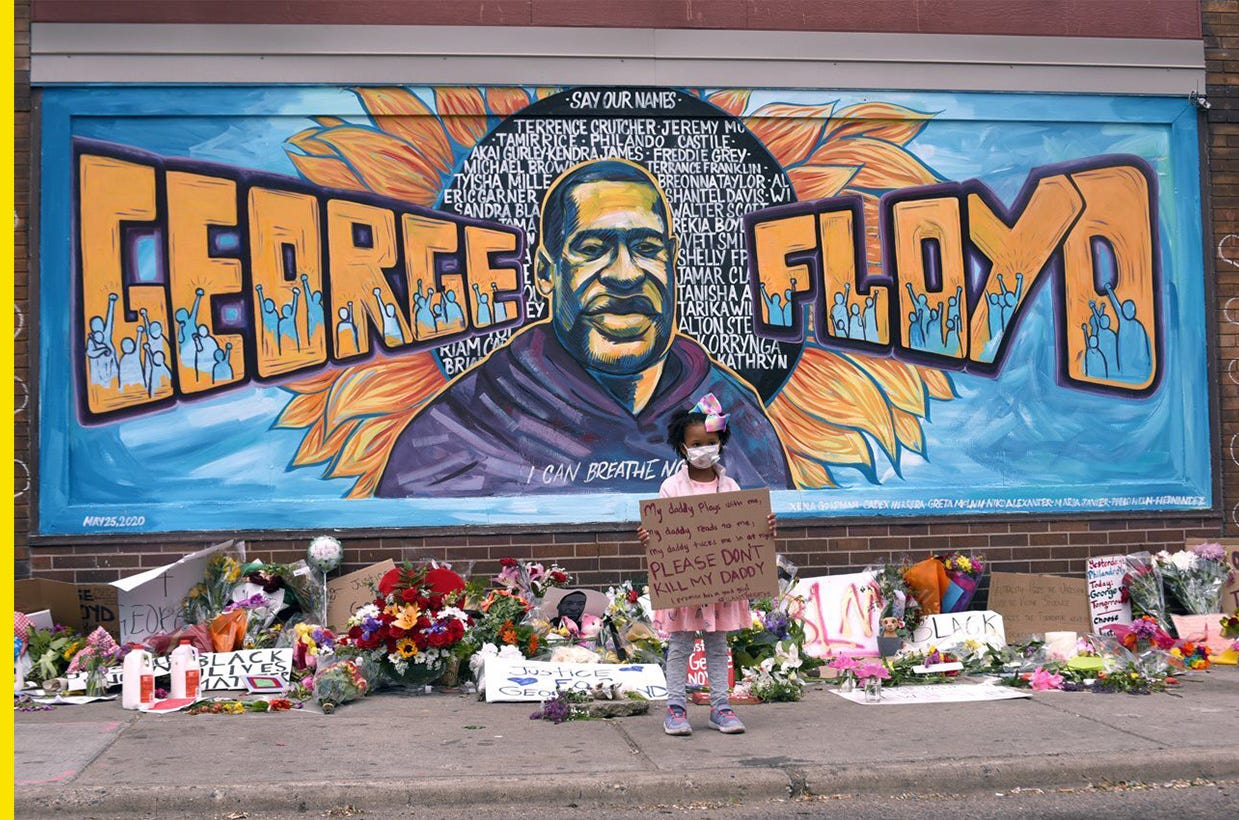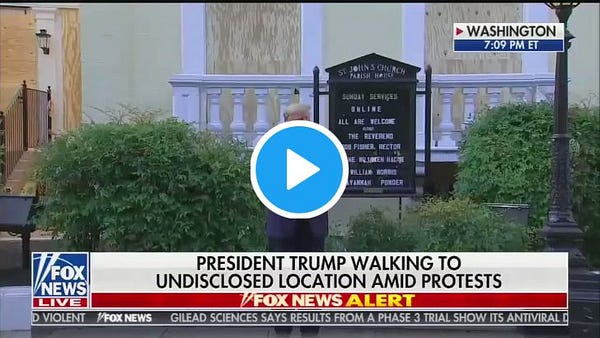The making of a photo op

What was so disorienting about President Trump’s church photo op was seeing for ourselves what went into the making of it. Also in this week’s issue:
This mural of George Floyd has become a memorial in Minneapolis
The story behind the now-iconic image of a man carrying an upside-down flag
Amy Sherald on the no-go White House portrait ceremony
Yours,
This mural of George Floyd has become a memorial in Minneapolis

Credit: via Barack Obama/Medium
Just days after George Floyd was killed while in police custody, a mural in his honor went up on the side of Cup Foods, the Minneapolis store he was arrested outside of. The wall previously had a farm landscape mural but was covered in graffiti following protests.
“It had been so badly tagged that it didn’t seem that anyone would mind that we were going to beautify it,” artist Xena Goldman told Yello in an interview.
Painting began at 7 a.m. last Thursday and the mural was finished about 12 hours later.
“It was very impromptu,” Goldman said. “Usually I’m a big planner, but it just seemed like time to act.”
The mural includes the words “I Can Breathe Now” written across Floyd’s portrait, a reference to Floyd saying “I can’t breathe” while a white officer pressed his knee into Floyd’s neck for more than eight minutes. The mural also includes the names of other black victims of police brutality so as to “connect the death of George Floyd to the bigger problem,” said Greta McLain, a community muralist.
Mourners leave flowers and messages there, and McLain said the mural has become an anchor for the community. “There’s been so much going on, I think the mural, especially being in that intersection, has really grounded us,” she said.
With many local businesses in the area destroyed, there’s a need for essentials like food and diapers, and the intersection has become a place where items are handed out, as well as a place to mourn and gather.
“It’s a place where you go to mark the loss of George Floyd but also mark the change in our city and to support and align,” McLain said.
Former President Obama used an image of the mural as a cover photo for his post on Medium about how to turn this moment into real change.
The artists who worked on the mural were Goldman, McLain, Niko Alexander, Maria Javier, Pablo Helm Hernandez, Rachel Breen, and Cade Herrera.
The making of a photo op
The White House released a short video Monday showing President Trump walking across Lafayette Square to St. John’s Episcopal Church. The video shows Trump holding a Bible for the cameras before walking back to the White House and pumping his fist for law enforcement lining the way.
What it doesn’t show is everything that went into making it.
The music used in the White House video is soaring and triumphant but it masks the sound of sirens that could be heard while Trump stood in front of the church.
It leaves out the smoke canisters, pepper balls, and flash bangs fired by law enforcement against peaceful protesters to clear them out just minutes before Trump claimed in a Rose Garden address to be an ally to peaceful protesters.
It leaves out Trump’s awkward handling of the Bible as he held it up, and his exchange with a reporter who asked, “Is that your Bible?” “It’s a Bible,” Trump responded.
Trump didn’t go inside nor did he open the Bible or mention Floyd. He stopped twice for photos and spent less than four minutes in front of the church, but that’s all you really need when putting together a 29-second video and some still photos.
Though some Christians were pleased with Trump’s actions, the Episcopal bishop of Washington, Mariann Budde, was not. Budde told the Washington Post she was “outraged” and that the church wasn’t notified “that they would be clearing [the area] with tear gas so they could use one of our churches as a prop.”
A pair of Republicans also spoke out. Sen. Tim Scott of South Carolina said tear gas should not be used for a photo op and Sen. Ben Sasse of Nebraska said Trump treated “the word of God as a political prop.” Most every other Republican who was asked about it didn’t have much to say.
Trump’s visit came after it was reported that he was taken to a White House bunker on Friday as protesters gathered outside. Trump was reportedly upset about news coverage of this and wanted images of him outside White House grounds.
The photo op was juxtaposed with another church visit the same day by presumptive Democratic nominee Joe Biden. Biden visited the Bethel A.M.E. Church in Wilmington, Del., where he met with community leaders, no smoke canisters necessary.
Subscribe to Yello for the latest news on the culture, branding, and visual rhetoric of politics, delivered each week:
The story behind the now-iconic image of a man carrying an upside-down flag
Of the many compelling images to come out of the past week, the photo of a man in Minneapolis walking past a burning building holding an upside-down flag was especially powerful.
The photo was snapped at 11:59 last Thursday night by Associated Press photographer Julio Cortez, who spotted the man and followed him down the street to get a shot in front of a liquor store, his body silhouetted behind the flag against the flames.
“When I saw the man walking up with the flag, I started getting closer,” Cortez told the AP. “I could tell this was going to be very visual, so I just followed along. I wanted to silhouette him, so I waited for him to walk where it was burning.”
The AP’s director of photography David Ake said the photo is powerful because it shows the flag upside-down, a universal symbol of distress, and because the man is unrecognizable. “It could be any person of any age, race, or gender,” he said. “It could be you or me.”
Cortez got another angle of the scene. While in Minneapolis he also shot photos of police emerging from a cloud of blue smoke and an officer’s silhouette in front of a burning building.
Amy Sherald on the no-go White House portrait ceremony

Credit: MSNBC
Amy Sherald, the artist behind former first lady Michelle Obama’s portrait for the National Portrait Gallery, spoke last Tuesday with MSNBC about the report that the Trump administration won’t be having the traditional White House portrait ceremony for the Obamas.
“I think it’s really sad that he’s leaving the tradition behind and I also think it’s very disheartening for the artists that have the opportunity to participate, to create these portraits, and become a part of a historical legacy,” Sherald said.
Sherald called the White House “a de facto museum” that holds an archive of the families who lived there before and that “you could really see Trump not holding this unveiling as an act of erasure” of the Obamas.
She also talked about her FLOTUS portrait and said she aimed to paint an image “that felt more private and more personal to who she was” as opposed to images we saw of Obama in the media. Sherald said the quilted-pattern dress Obama wore was a way to connect her with American and black history “without being too didactic.”
Confederate monuments targeted and taken down

Credit: WVTM
It’s wild to me that in the year 2020 we still have Confederate monuments up, but here we are.
Several monuments have been hit by taggers in the past several days, including monuments in Atlanta; Luray, Norfolk, and Richmond, Va.; and Oxford, Miss., according to local news reports. The Richmond headquarters of the United Daughters of the Confederacy, the group behind Confederate monuments across the country, was set on fire on Sunday.
Some communities have finally gotten proactive with their Confederate monuments. In Birmingham, Ala., the city removed a 115-year old obelisk on Monday night that was dedicated to Confederate soldiers and sailors. And in Alexandria, Va., the city pulled down a Confederate soldier statue on Tuesday morning that had been on display at a downtown intersection.











